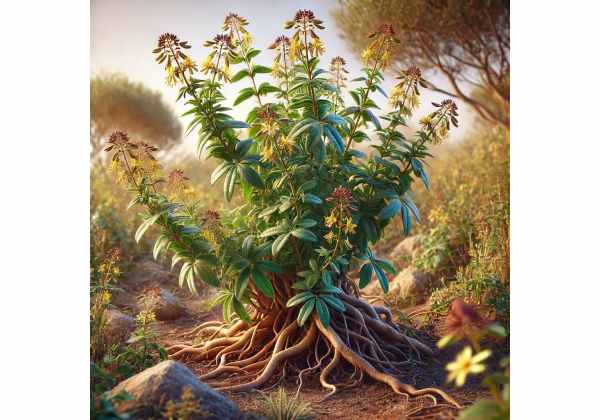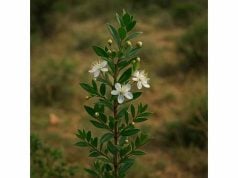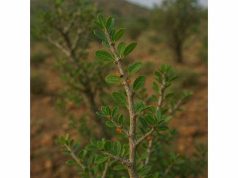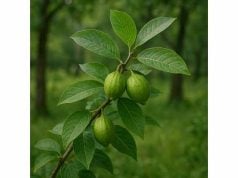
Madder is a traditional medicinal herb renowned for its vibrant red dye and potent healing properties. Derived from the roots of Rubia tinctorum, this herb has been used for centuries in natural remedies to promote circulation, support liver function, and alleviate pain. Rich in anthraquinones, flavonoids, and tannins, madder offers anti-inflammatory, antioxidant, and detoxifying benefits. Its diverse applications extend from traditional dyeing to modern herbal formulations that support skin health and joint function. This comprehensive guide explores madder’s botanical profile, chemical constituents, extensive health benefits, practical uses, and scientific research, providing an in-depth understanding of this multifaceted herb.
Table of Contents
- Botanical Overview and Identification
- Phytochemical Insights and Active Constituents
- Health Benefits and Core Qualities
- Practical Applications and Usage Precautions
- Scientific Research and Key Findings
- Frequently Asked Questions
Botanical Overview and Identification
Madder, primarily known by its scientific name Rubia tinctorum, is a perennial herb that belongs to the Rubiaceae family. Native to the Mediterranean region, this climbing plant has been cultivated for millennia for its natural dye and medicinal properties. It features slender, fibrous roots, which are the primary source of its vibrant red pigment, and its leaves are lanceolate with a glossy surface. The plant produces small, tubular, purplish flowers that eventually give way to tiny, berry-like fruits. Thriving in well-drained, calcareous soils and temperate climates, madder is renowned not only for its dyeing applications but also for its role in traditional herbal medicine.
Historically, madder was cultivated extensively in Europe and Asia for its dye, which was used to color fabrics, food, and art. Over time, its medicinal properties were discovered, and it became a staple in folk remedies for treating inflammation, pain, and liver disorders. Today, madder continues to be valued in both the natural dye industry and herbal medicine. Cultivation practices have evolved to focus on both sustainable agriculture and the preservation of genetic diversity, ensuring that madder remains an accessible resource for traditional remedies and modern herbal formulations alike.
The plant’s robust root system not only facilitates the absorption of nutrients in poor soils but also acts as a reservoir for its bioactive compounds. The identification of madder is typically based on its distinctive root structure and the coloration of its bark, which turns a deep red upon harvesting and processing. Its aerial parts, including the leaves and flowers, provide additional clues for botanical classification, allowing experts to differentiate it from other related species. This comprehensive botanical profile underpins madder’s historical importance and ongoing relevance in herbal medicine.
Modern botanical studies have also highlighted the ecological importance of madder. It is used in crop rotation and soil improvement strategies due to its ability to fix nutrients and stabilize soil structure. The synergy between traditional uses and contemporary agricultural practices ensures that madder remains a significant plant in both cultural heritage and sustainable farming.
In summary, the botanical overview of madder illustrates a plant that is as versatile as it is historically significant. Its unique morphological characteristics, adaptive growth habits, and rich heritage in natural dyeing and medicine make it a fascinating subject of study. This foundational knowledge sets the stage for exploring the intricate chemical makeup and extensive health benefits that madder offers.
Phytochemical Insights and Active Constituents
The therapeutic properties of madder are rooted in its complex phytochemical profile. Extensive research has identified a multitude of bioactive compounds within Rubia tinctorum that contribute to its medicinal efficacy. These compounds work synergistically to offer a range of benefits, from anti-inflammatory effects to natural detoxification. Below is an in-depth analysis of the key chemical constituents found in madder.
1. Anthraquinones
Anthraquinones are among the most important compounds present in madder. These pigments, which include alizarin and purpurin, are responsible for the characteristic red color of the dye extracted from the roots.
- Alizarin: Historically used as a red dye, alizarin also exhibits anti-inflammatory properties and has been studied for its potential in modulating cell signaling pathways.
- Purpurin: In addition to contributing to the dye’s vibrant hue, purpurin has demonstrated antioxidant activity, which may protect cells from oxidative stress.
2. Flavonoids
Madder contains various flavonoids that contribute significantly to its antioxidant and anti-inflammatory effects.
- Quercetin: Known for its potent free radical scavenging activity, quercetin helps reduce inflammation and supports cardiovascular health.
- Kaempferol: This flavonoid is recognized for its ability to combat oxidative stress and may play a role in preventing chronic diseases.
- Rutin: Rutin strengthens blood vessels and contributes to overall circulatory health while providing additional antioxidant protection.
3. Tannins
Tannins are polyphenolic compounds that are abundant in madder. They provide astringent properties that are useful in wound healing and reducing mucosal inflammation. Tannins also support digestive health by tightening tissues and reducing excessive secretions.
4. Coumarins
Coumarins found in madder are known for their mild anticoagulant and anti-inflammatory properties. These compounds help improve blood circulation and may contribute to the herb’s overall health benefits, particularly in the management of conditions related to poor vascular function.
5. Saponins
Saponins, a diverse group of glycosides, are also present in madder. They are credited with immunomodulatory and cholesterol-lowering effects, which further enhance the plant’s role in promoting cardiovascular health and overall metabolic balance.
6. Additional Minor Constituents
Beyond these major groups, madder contains various other minor compounds such as essential oils, sterols, and phenolic acids. These compounds, though present in smaller amounts, work in concert to boost the herb’s overall pharmacological profile, contributing to its diverse health benefits.
Synergistic Effects
The combined action of these phytochemicals results in a powerful synergistic effect. For instance, the antioxidant activities of anthraquinones, flavonoids, and tannins complement each other, offering enhanced protection against cellular damage. This synergy is believed to underlie many of madder’s traditional applications, from natural dye production to its use as a remedy for inflammation and pain.
Standardization and Extraction
Modern extraction methods, including high-performance liquid chromatography (HPLC) and gas chromatography-mass spectrometry (GC-MS), have been employed to isolate and quantify these active compounds in madder. Standardized extracts ensure that the concentration of these bioactive ingredients is consistent, thereby optimizing their therapeutic potential in both clinical and commercial formulations.
Summary
The phytochemical composition of madder is a rich mosaic of anthraquinones, flavonoids, tannins, coumarins, saponins, and other minor constituents. This intricate blend of bioactive compounds not only gives madder its vibrant color but also underpins its extensive medicinal properties. By understanding the individual and synergistic roles of these compounds, researchers and practitioners can better harness madder’s full potential in natural therapies and modern medicine.
Health Benefits and Core Qualities
Madder has been a cornerstone of traditional medicine for centuries, revered for its diverse range of health benefits. Its rich array of bioactive compounds works synergistically to support overall health and address specific ailments. The following sections outline the key health benefits and inherent qualities of madder.
Anti-inflammatory and Antioxidant Protection
Madder is highly valued for its potent anti-inflammatory properties. The anthraquinones and flavonoids present in the herb help to reduce the production of pro-inflammatory cytokines, thereby mitigating chronic inflammation. Concurrently, its robust antioxidant profile neutralizes free radicals, protecting cells from oxidative stress and reducing the risk of chronic diseases such as cardiovascular disease and certain cancers.
Support for Liver Health and Detoxification
Traditionally, madder has been used to support liver function and enhance the body’s natural detoxification processes. Its bioactive constituents promote bile secretion and facilitate the elimination of toxins. This hepatoprotective effect is particularly beneficial in conditions where liver function is compromised due to environmental toxins or metabolic stress.
Pain Relief and Muscle Relaxation
The antispasmodic and analgesic properties of madder have been widely recognized in traditional medicine. By relaxing smooth muscles and reducing spasms, madder can alleviate pain associated with conditions such as menstrual cramps, arthritis, and gastrointestinal discomfort. Its natural pain-relieving effects offer a safer alternative to synthetic analgesics for some individuals.
Cardiovascular and Circulatory Support
Madder’s ability to improve blood circulation is attributed to its vasodilatory and mild anticoagulant effects, primarily mediated by its coumarins and flavonoids. These compounds help to reduce blood viscosity, improve endothelial function, and enhance overall cardiovascular health. Regular use of madder may contribute to better blood pressure regulation and reduced risk of heart disease.
Skin Health and Wound Healing
The astringent properties of tannins in madder make it beneficial for skin health. When applied topically, madder extracts can help tighten skin, reduce inflammation, and promote wound healing. Its antioxidant properties also support the regeneration of skin cells, contributing to a more youthful and radiant complexion. Madder has been incorporated into traditional topical formulations for treating acne, eczema, and other inflammatory skin conditions.
Digestive and Gastrointestinal Benefits
Madder’s bioactive compounds stimulate the production of digestive enzymes, thereby improving digestion and nutrient absorption. Its antispasmodic effects also help in relieving gastrointestinal discomfort, making it a valuable remedy for conditions such as indigestion, bloating, and irritable bowel syndrome (IBS). This gentle support for the digestive system underscores its role in traditional herbal medicine.
Hormonal Balance and Menstrual Support
In folk medicine, madder has been used to regulate menstrual cycles and alleviate symptoms associated with menstruation. Its mild estrogenic effects, likely due to the presence of certain flavonoids, help balance hormonal fluctuations and reduce menstrual pain. This property makes it a popular choice among women seeking natural remedies for reproductive health.
Immune System Modulation
The combination of antioxidants, anti-inflammatory agents, and immunomodulatory compounds in madder supports the immune system by enhancing its ability to combat infections and reduce systemic inflammation. This comprehensive immune support is beneficial in maintaining overall health and resilience against common illnesses.
Summary
Madder offers a holistic spectrum of health benefits, from reducing inflammation and oxidative stress to supporting liver function, cardiovascular health, and skin regeneration. Its diverse pharmacological properties—ranging from pain relief and digestive support to hormonal balance and immune modulation—make it a versatile herb in both traditional and modern medicine. The integration of madder into daily health regimens can provide natural, multi-targeted support for overall well-being.
Practical Applications and Usage Precautions
Madder is utilized in a variety of ways across culinary, medicinal, and cosmetic fields. Its versatility is matched by the need for proper usage guidelines to maximize its benefits while ensuring safety. This section provides practical applications for madder and outlines important dosage recommendations and safety precautions.
Culinary Applications
- Natural Dye Production:
Historically, madder has been valued for its ability to produce a vibrant red dye. The roots are processed to extract the pigment, which has been used to color textiles, food products, and even art. Today, natural dye enthusiasts continue to use madder for eco-friendly textile dyeing. - Herbal Infusions:
Madder can be used to prepare herbal infusions or teas. A small amount of dried madder root is steeped in hot water for 10–15 minutes to create a beverage that is traditionally consumed for its digestive and detoxifying benefits. Its subtle earthy flavor complements other herbal blends.
Medicinal Applications
- Traditional Remedies:
In traditional medicine, madder is often used in decoctions and tinctures to treat inflammatory conditions, promote liver health, and alleviate pain. Its extracts can be incorporated into formulations aimed at relieving menstrual discomfort and supporting joint function. - Topical Applications:
Madder extracts are sometimes used in natural ointments and creams for wound healing and skin rejuvenation. The astringent properties of tannins in madder help reduce inflammation and promote faster recovery of damaged tissues. - Supplement Formulations:
Modern herbal supplements may include standardized extracts of madder, ensuring consistent levels of active compounds. These supplements are often used to support liver detoxification, promote circulatory health, and reduce systemic inflammation.
Cosmetic Applications
- Skincare Products:
Due to its antioxidant and anti-inflammatory properties, madder extract is used in natural skincare formulations. It is incorporated into serums, lotions, and masks to help improve skin tone, reduce signs of aging, and protect against environmental damage. - Hair Care:
Some natural hair care products feature madder extract for its ability to enhance scalp health and promote hair strength. Its mild astringent properties can help regulate sebum production, contributing to a balanced scalp environment.
Dosage Recommendations
- Herbal Tea:
A typical infusion uses 2–3 grams of dried madder root per cup of boiling water. It is advisable to start with a lower dose to assess individual tolerance before gradually increasing consumption. - Extracts and Capsules:
Commercial madder extracts should be used according to the manufacturer’s guidelines. Consulting a healthcare provider for personalized dosing recommendations is important, especially for individuals with underlying health conditions. - Topical Preparations:
When using madder-based creams or ointments, apply a small amount to the affected area. A patch test is recommended to ensure there is no allergic reaction before wider application.
Safety Precautions
- Potential Allergies:
While madder is generally well-tolerated, some individuals may experience allergic reactions. Signs of sensitivity include skin irritation, rash, or respiratory discomfort. Discontinue use immediately if any adverse reactions occur. - Pregnancy and Breastfeeding:
There is limited research on the safety of madder during pregnancy and breastfeeding. It is best to consult a healthcare provider before using madder-based supplements or extracts in these conditions. - Interactions with Medications:
Madder’s bioactive compounds can interact with certain medications, particularly those affecting liver enzymes or blood clotting. Individuals taking prescription medications should seek medical advice before incorporating madder into their regimen. - Quality Assurance:
Ensure that any madder products are sourced from reputable suppliers who adhere to good manufacturing practices. Organic, sustainably harvested madder is preferred to avoid contaminants and ensure maximum efficacy.
Best Practices for Use
- Gradual Introduction:
Introduce madder into your routine slowly, especially if you are new to the herb. This helps to minimize potential side effects and allows your body to adjust to its bioactive compounds. - Consistent Use:
For chronic conditions, consistency is key. Follow the recommended dosage guidelines and use madder regularly as part of a broader wellness strategy. - Professional Consultation:
Always consult a healthcare provider before starting any new herbal supplement, particularly if you have pre-existing health conditions or are on medication.
Summary
Madder is a versatile herb with applications spanning culinary, medicinal, and cosmetic fields. When used appropriately and in recommended doses, it can offer significant health benefits such as detoxification, anti-inflammatory effects, and skin rejuvenation. By adhering to safety guidelines and consulting with healthcare professionals, individuals can effectively integrate madder into their wellness routines while minimizing risks.
Scientific Research and Key Findings
Scientific research has increasingly validated the traditional uses of madder, revealing a wealth of information about its bioactive compounds and therapeutic potential. Numerous studies have focused on its anticancer, anti-inflammatory, and antioxidant properties, among others. Below is an overview of significant research findings that underscore the clinical and pharmacological relevance of madder.
1. Anticancer Research and Vinca-Independent Effects
Early research into madder focused on its dye properties, but subsequent studies uncovered its potential anticancer effects. Researchers have found that certain anthraquinones in madder can inhibit tumor growth by inducing apoptosis (programmed cell death) in cancer cells.
- Key Findings:
- Experimental models indicate that madder extracts can suppress the proliferation of various cancer cell lines.
- The mechanisms involve modulation of cell cycle regulators and induction of oxidative stress in malignant cells.
- Implications:
These findings open up new avenues for developing adjunct therapies in cancer treatment that harness natural compounds from madder.
2. Anti-inflammatory and Antioxidant Activities
Multiple studies have demonstrated that madder exhibits significant anti-inflammatory and antioxidant properties. Researchers have isolated flavonoids and tannins from madder that reduce levels of inflammatory markers and protect against oxidative damage.
- Key Findings:
- In vitro assays show a marked decrease in pro-inflammatory cytokines upon treatment with madder extracts.
- Antioxidant assays reveal strong free radical scavenging activity, which may help in preventing chronic diseases.
- Implications:
These properties support the traditional use of madder in treating inflammatory conditions such as arthritis and promote overall cellular health.
3. Hepatoprotective and Detoxification Effects
Research has also focused on madder’s ability to support liver health. Studies indicate that madder extracts enhance the detoxification process by stimulating bile production and reducing liver enzyme levels in models of hepatic injury.
- Key Findings:
- Animal studies show improved liver function tests and reduced histological signs of liver damage.
- The active compounds in madder help to mitigate the effects of toxins and oxidative stress on liver cells.
- Implications:
These findings validate the use of madder in traditional medicine for detoxification and liver support, suggesting its potential as a natural hepatoprotective agent.
4. Skin Rejuvenation and Wound Healing Research
The application of madder in skincare has been supported by research demonstrating its beneficial effects on skin health. Studies have highlighted its ability to promote collagen synthesis and accelerate wound healing due to its astringent and antioxidant properties.
- Key Findings:
- Topical application of madder extracts has been associated with reduced inflammation and improved skin texture in clinical trials.
- In vitro studies reveal enhanced cell migration and proliferation in skin cell cultures treated with madder.
- Implications:
These results support the incorporation of madder in cosmetic formulations aimed at anti-aging and skin repair.
5. Comprehensive Reviews and Future Directions
Several systematic reviews have consolidated the diverse research on madder, highlighting its multifaceted pharmacological profile.
- Key Findings:
- Reviews confirm the broad therapeutic potential of madder, emphasizing its role in anticancer, anti-inflammatory, and hepatoprotective applications.
- The need for more large-scale clinical trials has been noted to standardize dosages and validate long-term benefits.
- Implications:
Future research is expected to optimize extraction methods, enhance product standardization, and expand madder’s applications in integrative medicine.
Summary
The scientific evidence supporting madder’s therapeutic benefits is robust and multifaceted. From its anticancer properties and liver support to its anti-inflammatory, antioxidant, and skin-healing effects, research underscores the significant potential of madder as a natural remedy. Continued investigation and clinical trials will further elucidate its mechanisms of action and pave the way for innovative applications in modern healthcare.
Frequently Asked Questions
FAQ: What is madder and what are its traditional uses?
Madder, derived from the roots of Rubia tinctorum, is a traditional herb used for centuries to produce a natural red dye and treat various ailments, including inflammation, liver disorders, and pain.
FAQ: What are the key active compounds found in madder?
Madder contains anthraquinones (such as alizarin and purpurin), flavonoids, tannins, coumarins, and saponins, which contribute to its anti-inflammatory, antioxidant, and detoxifying properties.
FAQ: How does madder support liver health and detoxification?
Madder stimulates bile production and enhances detoxification processes, helping to protect liver cells from toxins and oxidative damage, which supports overall liver function.
FAQ: Can madder be used to improve skin health?
Yes, madder’s astringent and antioxidant properties promote collagen synthesis and accelerate wound healing, making it useful in natural skincare products for anti-aging and skin repair.
FAQ: Are there any safety concerns with using madder?
Madder is generally safe when used appropriately. However, high doses may cause gastrointestinal upset, and it should be used with caution by pregnant or breastfeeding women. Consult a healthcare provider before use if you have underlying health conditions.
Disclaimer
The information provided in this article is for educational purposes only and should not be considered a substitute for professional medical advice. Always consult with a qualified healthcare provider before making any significant changes to your diet or starting any new treatment regimen.
Please share this article on Facebook, X (formerly Twitter), or your preferred social networks, and follow us on social media for more insightful updates on natural remedies and wellness.










